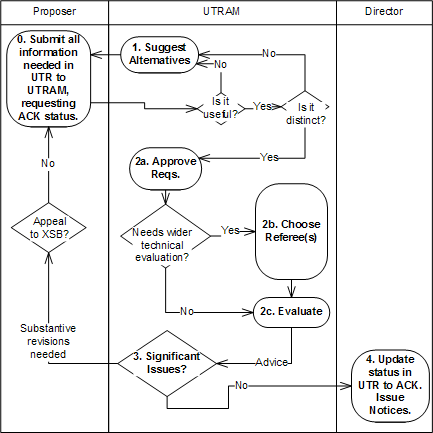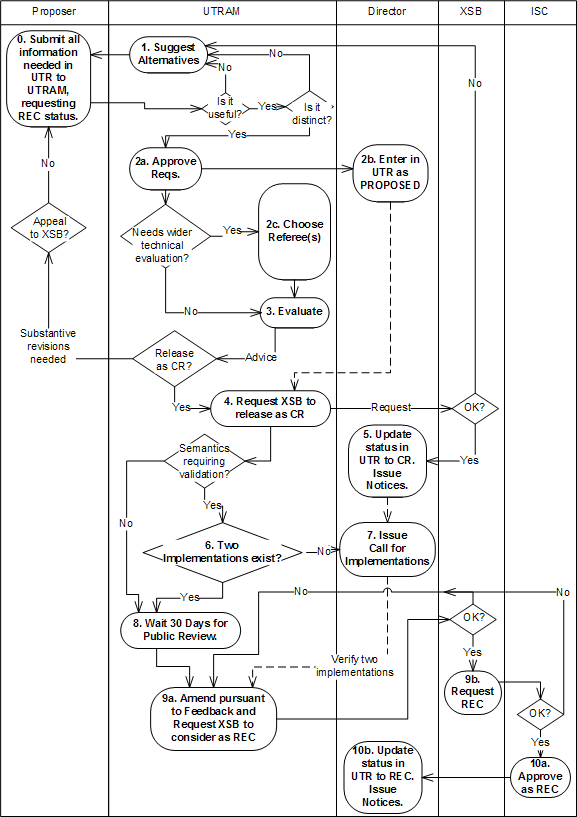1 Goals
XBRL provides a small set of standard units that may appear as QNames in the measure element of an XBRL instance document. These include "shares", "pure" and currencies as specified in the [XBRL 2.1] XBRL RECOMMENDATION. As XBRL applications have emerged, unit declarations have appeared in XBRL instance documents having multiple names for equivalent meanings, and identical names having different meanings. The goal of the XBRL Units Registry UTR is to be a public, online data set that documents these units and their usage. Additions and other changes to the UTR, like other XBRL International work products, are processed through a series of steps detailed in this document. The goal is to maximise the utility and longevity of the new units and the taxonomies that use them.
1.1 Relationship to other work
This document pertains to XBRL as defined in the XBRL Specification [XBRL 2.1] and additional modules such as the Data Types Registry [DTR STRUCTURE].
1.2 Terminology
The key words MUST, MUST NOT, REQUIRED, SHALL, SHALL NOT, SHOULD, SHOULD NOT, RECOMMENDED, MAY, and OPTIONAL, in this specification, are to be interpreted as described in [IETF RFC 2119].
abstract element, bind, concept, concrete element, context, Discoverable Taxonomy Set (DTS), duplicate items, duplicate tuples, element, entity, equal, essence concept, fact, instance, item, least common ancestor, linkbase, period, taxonomy, tuple, unit, taxonomy schema, child, parent, sibling, grandparent, uncle, ancestor, XBRL instance, c-equal, p-equal, s-equal, u-equal, v-equal, x-equal, minimally conforming XBRL processor, fully conforming XBRL processor and any other terms not specifically defined elsewhere in this document but which are used and defined in the XBRL 2.1 specification are as defined by [XBRL 2.1] .
BPB refers to the XBRL International Best Practices Board .
CR refers to a Candidate Recommendation of XBRL International.
ISC refers to the XBRL International Steering Committee .
IWD refers to an Internal Working Draft of XBRL International.
DTR refers to the Data Types Registry that is the subject of a different specification.
UTR refers to the Units Registry that is the subject of this specification.
UTRAM refers to the Units Registry Approval Manager.
PWD refers to a Public Working Draft of XBRL International.
Referee is either the SWG or TAPWG when performing an evaluation requested by the UTRAM.
SWG refers to the XBRL International Base Specification and Maintenance Working Group.
TAPWG refers to the Taxonomy Architecture Practice Working Group set up by the BPB.
TRTF refers to the Taxonomy Review Task Force set up by the BPB.
XSB refers to the XBRL International Standards Board .
1.3 Language
The official language of XBRL International's own work products is English and the preferred spelling convention is UK English.
All documentation supporting a registry entry MUST be provided in English, and MAY be provided in additional languages.
1.4 Document conventions
1.4.1 Typographic conventions
1.4.1.2 Footnote notation
Comments which are informative, but not essential to the understanding of the point at hand, are provided in footnotes. All footnotes are non-normative.
1.4.1.3 Element and attribute notation
When referring to a specific element, it will be identified by
its namespace prefix and local name. For example, the root
element for a specification container element would be referred to as
<variable:generalVariable> .
Attributes are also identified by their local name and, where
appropriate, their namespace prefix. Attributes are
distinguished from elements by prefixing them by an
@
symbol. Thus,
@id
refers to the attribute with the name id.
When referring to any attribute, so long as it has a specific
namespace, the local name is replaced by an asterisk (
*).
Thus, the notation @xml:* specifies any attribute
in the namespace
http://www.w3.org/XML/1998/namespace.
1.4.2 Formatting conventions
The following highlighting is used for normative technical material in this document:
Text of the normative example.
The following highlighting is used for non-normative examples in this document:
Text of the helpful example.
Next paragraph of the helpful example.
Example 3 shows the formatting for non-normative examples of poor, discouraged or disallowed usage.
The example itself.
2 Update Process
The process by which an entry is added to the UTR is described below. This is modelled on [TECH-WG-PROCESSES] but is shortened to reflect the fact that the nature of an UTR entry is significantly less pervasive than that of a specification or other work product that is the usual output of a Working Group.
In addition a "fast track" process is provided whereby units that do not necessarily have general applicability (and so are unlikely to qualify for RECOMMENDED status) can nevertheless be included in the UTR as "Acknowledged".
The process starts when the submitter creates a submission containing all of the information needed (as specified in [UTR STRUCTURE]) and requests the UTRAM to enter it into the UTR. The submitter MUST indicate whether they are seeking Acknowledged or RECOMMENDATION status. If they are seeking Acknowledged status then the subsequent steps are as detailed in Section 2.1, if they are seeking RECOMMENDATION status then the subsequent steps are as detailed in Section 2.2.
Submitters should note that the initial status of their submission MUST be "PROPOSED" (see [UTR STRUCTURE]).
2.1 Steps to achieve Acknowledged status
A "fast track" process is provided to facilitate the inclusion of a unit in the UTR which may not have general applicability but which the submitter would, nevertheless, like to have documented in a publicly accessible fashion. A unit that successfully follows this "fast track" process will have an ending status of "ACK". As such it does not carry the same normative weight as a unit with "REC" status.
- The UTRAM MAY suggest alternatives to the proposal and request to its editors that it be resubmitted as they see fit. In the event that there is more than one submission made for similar requirements, or if the submission is substantially similar to an entry that is already present in the UTR then the UTRAM MAY request the submitters to agree a common solution between themselves and resubmit a single joint submission. If this is not acceptable to the submitters the XSB will be requested to arbitrate. In any event a submitted unit MUST NOT have the same identifier as any other unit already in the registry, regardless of namespace.
- The UTRAM approves the requirements and conducts a technical evaluation. If the UTRAM determines that wider technical evaluation is necessary then the UTRAM MAY then refer the submission to any or all (at their discretion) of the SWG or the TAPWG (hereinafter the referee) for such technical evaluation.
- If there are significant objections or problems arising as a result of this evaluation the UTRAM MAY request the submitter to address such issues. The submitter may then either modify the submission and resubmit, withdraw the submission, or appeal to the XSB.
- If there are no significant objections or problems arising as a result of this evaluation the unit is entered into the UTR with a status of "ACK" and the process is complete.

|
2.2 Steps to achieve RECOMMENDATION status
A unit that follows this track will have a status that is normative to the extent documented in Section 4 ("Normative Status of Unit Identifiers in the UTR and Software") of [UTR STRUCTURE]. Thus the process is, necessarily, considerably more rigorous than for a unit that follows the "fast track" process leading to "Acknowledged status".
- The UTRAM MAY suggest alternatives to the proposal and request to its editors that it be resubmitted as they see fit. In the event that there is more than one submission made for similar requirements, or if the submission is substantially similar to an entry that is already present in the UTR the UTRAM MAY request the submitters to agree a common solution between themselves and resubmit a single joint submission. If this is not acceptable to the submitters the XSB will be requested to arbitrate.
- The UTRAM approves the requirements and conducts a technical evaluation. This shall include an initial check that no submitted unit has the same local name as any other unit already in the registry, regardless of namespace. Provided this initial check is passed the entry is added to the UTR with a status of "PROPOSED". If the UTRAM determines that wider technical evaluation is necessary they MAY then refer the submission to any or all (at their discretion) of the SWG, the TRTF or the TAPWG (hereinafter the referee) for such technical evaluation.
- If requested in the previous step the referee deliberates the submission. If they are satisified then they recommend to the UTRAM that they approve release of the submission as a CR. If they are not satisfied they advise the UTRAM giving their reasons. The UTRAM in turn notifies the submitter who MAY then either modify the submission and resubmit, withdraw the submission, or appeal to the XSB.
- The UTRAM approves the submission and recommends to the XSB that it be released as a CR. (Note that, in the interests of a speedy process, this bypasses the PWD step of [TECH-WG-PROCESSES]).
- Upon approval of such publication by the XSB, the UTRAM updates its status in the UTR to CR. A notice of this change is made in the same way as such notices are published according to [TECH-WG-PROCESSES] and feedback requested.
- The UTRAM or, if they decide to delegate this step, the referee verifies that the conformance suite tests are valid and that there are two separate implementations that pass them. This step is only necessary if a conformance suite is required (i.e. if there are specific semantics associated with the entry that require software validation)
- If the submission affects the semantic processing of either taxonomies or instances the UTRAM calls for two implementations in the same way as a "Call for Implementations" is made according to [TECH-WG-PROCESSES]. This stage may be bypassed at the discretion of the UTRAM if it is known that two implementations already exist or if semantic processing is not affected.
- A minimum of 30 days of public review follow.
- If a "Call for Implementations" has been issued this step MUST NOT begin until two such implementations are known to the UTRAM. The UTRAM or, if they decide to delegate this step, the referee makes any necessary amendments pursuant to the CR feedback and, unless it determines that a new CR is necessary, the UTRAM recommends to the XSB that it be published as a RECOMMENDATION.
- The XSB approves the RECOMMENDATION and the status of the entry in the UTR is changed to "REC".

|
The process by which an entry may be updated in the UTR is analogous. If errata are discovered in any units with "REC" status then a new version of the unit will be entered into the registry following the same process as that used for errata corrections to the specification itself. The effective date of the errata corrected version will be later than that of the original and will thus supersede it.
2.3 Withdrawing a Unit Identifier
Unless a unit has the status of "REC" it may be withdrawn from the UTR at any time upon request of the original submitter. Such request MUST be made to the UTRAM by e-mail to the address published at http://www.xbrl.org/utr.
A unit with the status "REC" MAY NOT be withdrawn in this manner but MUST follow the process in Section 2.4 for rescinding a RECOMMENDED unit.
2.4 Rescinding a RECOMMENDED Unit Identifier
The process of rescinding a unit is not defined. If a situation arises whereby it becomes necessary to do so it will be defined following the model of [TECH-WG-PROCESSES].